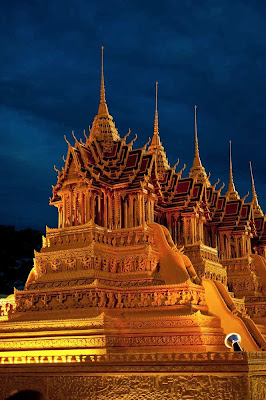 |
| The Forest Monk, Luang Paw Pohm Likit |
"The report of my death was an exaggeration" is a phrase attributed and often quoted in several versions to the American writer Samuel Clemens ("Mark Twain") in May 1897 when newspapers confused about his cousin's illness reported that Samuel had died. This quote is sometimes given as "The reports of my demise are greatly exaggerated" , "The report of my death have been greatly exaggerated", "Rumors of my death have been exaggerated".
Recently I was confronted with a similar situation albeit not as serious as the situation that Mark Twain found himself in so many years ago.
We have been going out to Wat Ban Mat often to visit the Forest Monk, Luang Paw Pohm Likit. Duang likes to make merit at the Wat along with the the other lay people who visit the Wat. The local people are very friendly and accepting. Duang enjoys communing with them and I quite comfortable around them.
Duang's father is dying. He has been dying since July but recently he has been wasting away more rapidly. Periodically he will go to the hospital for relief and some comfort from his ailment. After 3 or 4 days in the Kumphawapi Hospital, he returns to his home in Tahsang Village.
Three weeks ago Duang's father was back in the hospital. This was also during the time that the workers were painting our house. Duang goes to Wat Ban Mat to make merit and get a sort of comfort from consulting with the forest Monk and lay people. Because of the need to have one of us at the house while people were working, I have not been accompanying her out to the Wat.
One afternoon upon returning home, Duang found me ill at home. It was not serious for me - some sort of gastro-intestinal distress. After two hours I was fine but Duang was concerned and asked me if I needed to go to the hospital. Of course not! It was nothing serious.
A couple days later Duang told me that Buddha was going to see her father at the hospital in Kumphawapi some 40 miles away from Wat Ban Mat. I thought that was very nice considering that the Monk did not know her father, the distance involved and the fact that Duang had only recently started going to his Wat.
A couple of days later, Duang called me from the hospital where her father was staying. Luand Paw Pohm Likit and some people from the Wat had come to the hospital to see me. Me? She was laughing. Apparently they all thought that I was sick and in the hospital. They came to visit me and bring some special herbs to help cure me! Luang Paw Pohm Likit had been confused why I was in a hospital so far from our home. The Army Hospital where we go for healthcare is 3/4 mile from our home. He was also confused when he did not find me in the Kumphawapi Hospital. Eventually he found Duang and everything got clarified and straightened out. Duang called me to let me know that Buddha, a term she uses for Monks, was going to stop and visit me at the house on his way back to his Wat.
Shortly after Duang returned home, the Monk and six people from Ban Mat pulled up to our home. Everyone enjoyed a good laugh upon seeing me in great health and recounting the story of their visit to the Kumphawapi Hospital.
With this being Isaan, and everyone being interested in every one's personal life. the lay people had to have a tour of our home. Luang Paw Pohm Likit remained with me in the living room but he was in the spirit of it all by asking me how much we had paid for the house.
After about 30 minutes, our visitors left; promising to return at the beginning of the new year to eat at and bless our home.
I can best and happily describe my situation as "Rumors of my demise were greatly miscommunicated" I doubt that this quote will ever approach the fame of Mark Twain's but I doubt his provided as many laughs or smiles as mine.
Although this event could be considered somewhat a comedy of errors, for me it was another example of the sense of community and concern demonstrated by the ethnic Lao people here in Isaan. I am a falang (foreigner) here in Isaan but it appears that I have willingly been accepted by the people. That is a precious gift no matter who or where you are. It is just so much easier here in Isaan than in many places.


































